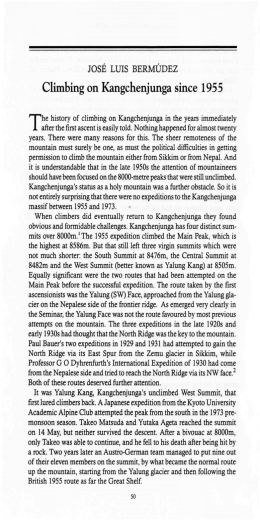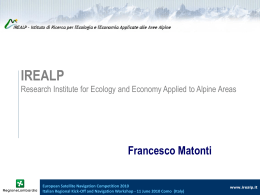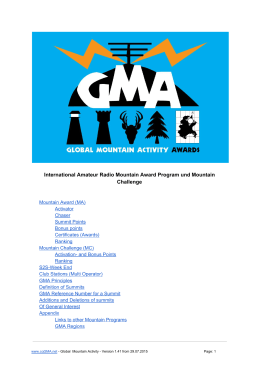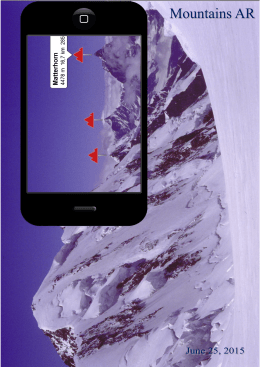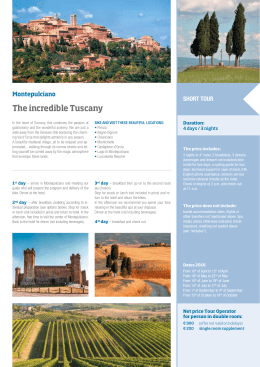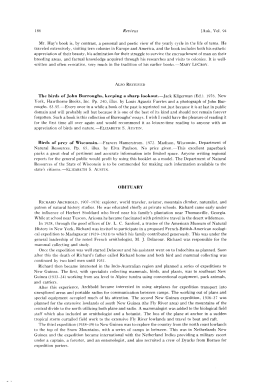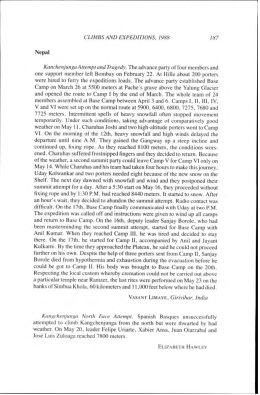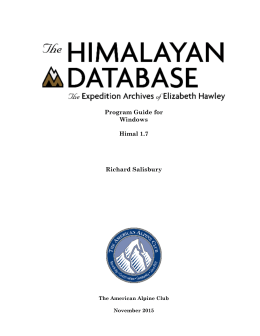C A RUSSELL One Hundred Years Ago (with extracts from the Alpine Journal) (Plates 60-64) T he night, thanks to the moon, was almost as bright as day, but even, low down as we were then on the moraine, where hardly a breath of air was stirring, it was bitterly cold. The snow was, as usual this winter, absolutely perfect and we forced our way rapidly up the two ice walls, emerging on the small snowfield below the "Schneekuppe" or lower peak of our mountain. The wind caught us fairly here, and the cold became almost unbearable. In a few minutes we were all literal impersonifications of Winter. At 6.50 we reached the Schneekuppe just as day broke. The Sattel was crossed and now only the last peak, abrupt and splendid, just gilded rosyred by the rising sun, rose before us. At 7.20 we stood on the actual summit, staying only a moment to scrawl our names with shaking fingers on one of the many cards decorating the little cairn, and then fled, never halting till we reached the Sella Pass and warm sunshine. The second winter ascent of Piz Roseg, on 26 February, was one of a number of fine expeditions in the Bemina Alps undertaken by E L Strutt1 with the guides Martin Schocher and Sebastian Platz during the early months of 1899. On 18 February, accompanied by William Williams, the party completed a traverse of the four Bellavista peaks under winter conditions before reaching the summit of Piz Zupo and on 4 March traversed Piz PaIn after joining forces with Leonard Rawlence. Strutt, one of the most experienced winter mountaineers of his day, later recalled that ... In the marvellous winter of 1898-99 we accomplished many climbs great and small. I did no less than twelve mountains above lO,OOO ft. myself, and the Bernina was accomplished three times in one week. Strangely enough, the snowfall of this winter was the heaviest that I have seen in ten winters in the Engadine. On the Piz Palii ridge the heat was so great that we took off our coats - a pleasant contrast to Piz Roseg. Throughout the winter the development of ski mountaineering was continued by small groups of enthusiasts and several long expeditions were undertaken. In the Zermatt district on 6 January Hans BieWy, Robert 202 ONE HUNDRED YEARS AGO 203 Helbling and Eduard Wagner, without guides, made the first ski ascent of the Breithorn, arriving on the summit in shirt sleeves. A few days earlier the fIrst recorded fatal accident to ski mountaineers in the Alps occurred on 2 January when Gustav Monnichs and Dr Reinhold EWert, who had both taken part in the ftrst traverse on ski of the Bernese Oberland,2 were killed by an avalanche on the Susten Pass. The early part of the summer was sunny and warm in many Alpine regions and conditions remained settled, with only the occasional storm, throughout the mountaineering season. The beautiful weather continues and seems likely to last and Zermatt is very full. The climbing season is one of the most brilliant on record. From the top of the Gornergrat parties may be seen on all the mountains round about - 32 persons were on the Matterhorn on Monday and about the same number on the Monte Rosa and Breithorn. As in the previous year many parties were able to take advantage of the ideal conditions and numerous expeditions of note were completed. In the Mont Blanc range on 11 July Emile Fontaine, accompanied by Joseph Simond and Joseph Ravanel, reached the Grands Montets ridge of the Aiguille Verte before making the first ascent of the prominent gendarme which he named the Aiguille Carn~e. Later in the season, from 23 to 26 August, GB and G F Gugliermina and Natale Schiavi with Nicola Motta completed the first traverse of the Col Emile Rey, the remote col below the Brouillard ridge of Mont Blanc; because of serious stonefall the party was obliged to bivouac three times while ascending from the Brouillard glacier and once during the descent by way of the Mont Blanc and Miage glaciers. Other new routes included the E, Forbes ridge of the Aiguille du Chardonnet, ascended on 30 July by L Hand Theodore Aubert with Maurice Crettez, and the SSE ridge of the Aiguille de Rochefort climbed on 20 August by Max Schintz with Joseph Croux and Alois Pollinger junior. In the Arolla district on 25 August the Rev James Outram and his brother the Rev William Outram accompanied by Jean Ma'itre reached the summit of the Grande Dent de Veisivi by way of the unclimbed S ridge. Also in the Pennine Alps, on 16 July, Walther Flenderwith Heinrich and Alois Burgener forced a very dangerous route up the E face of the N adelhorn. On 5 September, after traversing the Nordend of Monte Rosa, Flender accQm-panied by Heinrich Burgener and Ferdinand Furrer completed the ftrst descent of the NE ridge or Cresta di Santa Caterina which was at that time still unclimbed. Another notable achievement was the first guideless ascent of the Teufelsgrat, the WSW ridge of the Tiischhorn, by a party which included Eduard Wagner. During the afternoon of 27 August 0 G Jones with the guides Elias Furrer and Clemenz Zurbriggen arrived at the Bricola chalets, accompanied by F W Hill and his guide Jean Vuignier. Hill later recalled that early on 60. Dent Blanche from W with centre, L of great couloir, the Ferpecle ridge. 204 THE ALPINE J OURN AL 1999 the following day both parties had begun the ascent of the W, Ferpecle ridge of the Dent Blanche, a climb which was to end in tragedy. After reaching the ridge the two parties, now roped together, 'made good progress, for at ten o'clock it was agreed that we were within an hour of the summit.' ... It was just at this time that Furrer found his way blocked. The obvious route lay up a narrow gully or sloping chimney, but here the rocks were glazed and impossible. About 30 ft. to the left was a smooth-looking buttress some ten feet high; in between was a vertical rock face. When I reached the level of the others, Furrer was attempting to climb the buttress but, finding no holds, he called to Zurbriggen to hold an axe for him to stand on. Apparently he did not feel safe, for he turned his head and spoke to Jones, who then went to hold the axe steady. Thus we were all on the same level, Vuignier being some 25 or 30 ft. distant from them and also from me. Standing on the axe, which was now quite firm, Furrer could reach the top of the buttress, and attempted to pull himself up; but the finger-holds were insufficient, and before his foot had left the axe his hands slipped, and he fell backwards on to Zurbriggen and Jones, knocking them both off, and all three fell together. I turned to the wall to get a better hold, and did not see Vuignier pulled off, but heard him go, and knew that my turn would soon come. And when it did not I looked round, and saw my four companions sliding down the slope at a terrific rate, and 30 ft. of rope swinging slowly down below me. It is difficult to analyse my sensations at that moment. My main feeling was one of astonishment that I was still there. I can only suppose that Vuignier had belayed my rope securely to protect himself and me during our long wait on the traverse. Left alone on the mountain Hill managed to complete the climb and to descend the S ridge, arriving in Zerrnatt on 30 August after two nights in the open - a remarkable solo achievement. As Hill was making his solitary traverse the second stage of an unusual expedition was taking place on the SE, Furggen ridge of the Matterhorn. On 24 August Guido Rey and the guide Antoine Maquignaz with Aime Maquignaz as porter had attempted without success to ascend the difficult upper step with the aid of a rope lowered by David Maquignaz and other members of the party who had descended the ridge from the summit to the top of the step. Four days later Rey and his guides reached the summit by way of the SW, Italian ridge and, as he recalled in the following year, descended the Furggen ridge ... as far as the place reached by David's party on the previous occasion. From this point we managed to descend a few metres further. We were then stopped by the well known overhanging wall. We here fixed a rope 61. The guide Mattias Zurbriggen and Mrs Fanny Bullock Workman on the Siegfriedhorn, 7 August 1899. (Dr W H Workman, 1899) (p202) 62. D Vj Freshfield at a camp below the Jongsong La, October 1899. (Vittorio Sella, 1899) (p202) ONE HUNDRED YEARS AGO 205 ladder, and by its means I descended the wall to the point that we had reached in the attempt of the 24th, and even went a few yards lower. I then reascended by the same ladder. Thus I had touched every point of the Furggen ridge, and the exploration of the same was complete. Rey's expedition aroused considerable interest at the time but many years were to elapse before the upper section of the ridge would be climbed without such assistance. In the Bemese Oberland on 19 July Julien Gallet with Josef Kalbermatten and Abraham Muller senior opened a fine route on the Gross Doldenhom, climbing the N spur of the ENE ridge before following the upper section of the ridge to the summit. On 7 September JosefLiniger, Robert Winterhalter and Johann Balli completed another new route, reaching the summit of the Hinter Fiescherhorn from the Klein GrunhornIiicke by way of the SSE ridge. To the east in the Bernina Alps two of the three N buttresses of Piz Palu were climbed for the first time: the buttress below the W peak by J T BurtonAlexander with Christian Zippert and Florian Grass on 31 July; and, on 22 August, the buttress leading to the E peak by Moritz von Kuffner with Martin Schocher and Alexander Burgener. Another notable expedition, on 13 August, was the first guideless ascent of the Biancograt, the classic N ridge over Piz Alv to the summit of Piz Bernina, by a party which included Franz H6rtnagl and Victor Wessely. In the Dolomites several fine routes were completed without guides including the first ascents of two of the Sella Towers by Otto Ampferer, Karl Berger and Wilhelm Hammer on 9 August and, on 24 August, the first complete traverse of the three main Vajolet Towers by Hans Barth and Eduard PichI. On 18 August the renowned Campanile Basso - the Guglia di Brenta - which had been attempted by several strong parties was climbed by Ampferer and Berger, an outstanding achievement for the period. On 6 September a notable expedition was completed in the Dauphine by Ernile Piaget accompanied by Louis and Prosper Faure and J Savoye. After forcing a new route up the NW face of the Montagne des Agneaux along the line of a couloir now known as the Piaget couloir the party ascended steep slopes to reach the Nw, lowest peak before traversing the summit ridge. During the year several expeditions of note were undertaken in other mountain regions. In Norway Geoffrey Hastings, accompanied by Elias H0grenning as porter, continued his exploration of the Lyngen Peninsula. During a period of mixed weather they made a number of ascents and on 3 July succeeded in traversing Jiekkevarre (1833m), the highest peak in the district. Earlier in the day after completing the first ascent of Store Durmalstind, which they calculated to be 1766m in height, at 3.55am Hastings and his companion were joined on the summit 206 THE ALPINE JOURNAL 1999 by Mrs Elizabeth Main3 with her guide Josef Imboden and his son Emil. Mrs Main and her party also completed a number of successful climbs including, on 18 July, the first ascent of Balgesvarri (1622m). To the north of the Lyngen Peninsula an interesting new route was completed on 20 July when Kristian Bing and Peder Grande made the first ascent of the famous North Cape, following a line up the N pillar. They started between 11 and 12 o'clock at night, thanks to the midnight sun. The sea was by no means placid, and the landing from their boat difficult. The rocks were loose and handholds untrustworthy. But the risk from these causes was as nothing compared to the danger from falling stones when they had accomplished the moiety of the ascent. Hundreds of missiles fell round them, and it was not till they reached the top that they found out the cause of the cannonade. A great company of tourists had visited the Cape, and many of them had amused themselves by throwing or kicking stones down the steep sea-cliff. The height climbed was about 1,000 ft. In East Africa on 26 July H J Mackinder, Reader irr Geography at Oxford, his friend C B Hausburg and two naturalists, E H Saunders and C F Camburn set out from the railhead4 at Nairobi to attempt the ascent of Mount Kenya (5199m). The party was completed by the guide Cesar OIlier and a porter, Joseph Brocherel, both from Courrnayeur, and by 164 Africans irrcluding 59 men from Zanzibar. Despite a serious shortage of food and the loss of two porters who were killed irr an ambush three high camps were established as the mountairr was approached by way of the Hohne! and Teleki valleys. Although two attempts to reach Batian, 5 the highest point, were unsuccessful Hausburg was able to take a series of photographs while completing a circuit of the main peaks with OIlier and Brocherel. On 12 September, after assistance had been obtained from the Government station at Naivasha, Mackinder, OIlier and Brocherel made a third attempt, startirrg from the Lewis glacier. Addressirrg the Alpirre Club in the following year Mackinder recalled how after spending the night in a Mummery tent at a height of some 5000m on Nelion 6 (5188m), the lower of the summit peaks, the party traversed the head of the Darwin glacier, climbed a rock rib for a short distance ... and then struck across the small but steep and very hard glacier 7 hanging from the col between the peaks. It frequently took thirty blows to cut a single step, and we were 3 hrs. in crossing, though it had appeared that 20 min. would suffice. We reached the higher summit at 12 o'clock on September 13. It was entirely devoid of snow. ... Though we were all most anxious to climb the other peak, the afternoon storm was threatening and the risks appeared too great. 63. The Kangchenjunga group from Darjeeling. (Vittorio Sella, 1899) (P202) ONE HUNDRED YEARS Aao 207 The expedition, which was supported by the Royal Geographical Society, was an adventurous undertaking, the ascent to the highest point of Mount Kenya being a notable achievement. On I July Dr William Hunter Workman and his wife Fanny Bullock Workman accompanied by the guide Mattias Zurbriggen left Srinagar with a local party to commence the second of their remarkable mountain journeys. After crossing the Skoro La (5073m) and engaging 50 porters at Askole they ascended the Biafo glacier, arriving on 29 July at the Hispar Pass where a number of photographs were taken in perfect weather. Returning by the same route the party ascended and named two peaks: the Siegfriedhorn, 8 rising above the Skoro La and calculated by the party to be 5669m in height, on 7 August; and four days later Mount Bullock Workman, a neighbouring peak to which they ascribed a height of 5928m. Later in the month on 25 August a third peak, Koser Gunge (640Im) above the Shigar valley, was climbed despite a deterioration in the weather. In the Punjab Himalaya a successful expedition was completed in June· by Dr Ernest Neve. With Geoffrey Millais and two local men he climbed the E, highest peak (5 I42m) of the Haramukh group near the Sind valley. On 5 September D W Freshfield left Darjeeling on the first stage of his celebrated Tour of Kangchenjunga (8586m). Freshfie1d was accompanied by E J Garwood, the brothers Emilio and Vittorio Sella, Erminio Botta9 and the guide Angelo Maquignaz all of whom had travelled with him from Europe, by the pundit Rinzin Namgyal lO and by Edward Dover, an official on the staff of the Political Officer in Sikkim. The party, which had an escort of six Gurkhas, was completed by some 50 local men from Darjeeling and Gangtok who volunteered as porters. After following a route round the SE flanks of the Kangchenjunga group good progress was made until a heavy snowfall, which commenced on 24 September, ended Freshfield's hopes of high ascents and new passes above the Zemu glacier. Despite a metre of new snow the party succeeded in completing the journey, crossing the Jongsong La (6120m) on 6 October and returning to Darjeeling on 25 October after visiting the village of Ghunsa in Nepal, traversing the Kang La and reaching another pass, the GuichaLa. Although conditions were unsuitable for serious climbing the party made a considerable contribution to the exploration of the Kangchenjunga region: Freshfield, with his exceptional experience of high mountains, W.iiS able to examine the western approaches and to comment on possible routes of ascent; Garwood prepared a detailed map of the Kangchenjunga glaciers; and Vittorio Sella took many fine and instructive photographs. In the preface to his book Round Kangchenjunga ll Freshfield explained that This volume is a description of the first Tour of Kangchenjunga made by .Europeans. Its object is not so much to offer another tale of mountaineering adventure as to provide an account of the scenery and glacial features 208 THE ALPINE JOURNAL 1999 of the Kangchenjunga Group that may be serviceable to Alpine climbers and men of science, and not without interest for those who 'love the glories of the world' and count among them great mountains. In Canada the recreational facilities provided by the Canadian Pacific Railway Company were enhanced by the introduction of professional Swiss Alpine guides. Eduard Feuz senior and Christian Hasler who were stationed at Glacier House 12 joined forces during the season to complete two notable new routes in the Selkirk range: the ascent of Mount Sir Donald (3297m) by way of the SW and SE ridges with Heinrich Cordes and F Leprince-Ringuet on 26 July; and, on 13 August with C E Fay and H C Parker, the first ascent of Hasler Peak (3390m), the E, highest summit of Mount Dawson. In Britain exploration was continued by many strong parties and several expeditions of note were completed. In Wales at Easter 0 G Jones, accompanied by A P and G D Abraham, made a number of new ascents induding North Buttress Climb and Milestone Buttress Ordinary Route on Tryfan and Hanging Garden Gully in the central cliff of Clogwyn y Geifr above Uyn Idwal. In the Lake District on 7 January Jones, leading G D Abraham and A E Field, completed one of his finest routes - Walker's Gully on Pillar Rock. On the Isle of Skye in September, after climbing Sgurr Alasdair with the Hon C G Bruce and a Gurkha, J N Collie took the photograph which confirmed the position of the Cioch, the rock pinnacle on the face of Sron na Ciche. An event which aroused considerable interest was the publication of Hints and Notes, Practical and Scientific, for Travellers in the Alps, a revision of the General Introduction to the Alpine Guide, the classic series by John Ball, the first President of the Alpine Club. The new edition was prepared by W A B Coolidge who explained that his aim had been ... to follow Mr Ball in supplying information suitable for those who have already some knowledge of the Alps and of travelling abroad, the book being in no sense intended for trippers and the host of ordinary tourists. Other books published during the year included The Highest Andes, the account by E A FitzGerald of his expedition to Aconcagua and Tupungato, and From the Alps to the Andes, the autobiography of the guide Mattias Zurbriggen. This account is concluded, in recollection of 0 G Jones, with an extract from the notice by H C Bowen which appeared in the Alpine Journal. The tragedy of August 28, the details of which are still fresh in all our minds, has deprived the Club of one who, in his own way, was amongst the most distinguished of the younger generation. 0. G. Jones may not 64. Siniolchu (6887m) from the NE. (Vittorio Sella, 1899) (p202) ONE HUNDRED YEARS AGO 209 have been a great mountaineer - that honoured title is scarcely to be won at his early age, and he would, I am sure, have been the last to claim it for himself; but he stood, beyond a doubt, in the first rank of English rockclimbers.... His life was lost in what seems, so far as we can tell, to have been a pure accident, which no skill of his could avert. For himself alone, it is probably the death he would have chosen, but for us who knew him it is sad to think how much energy and courage, how much hope and promise, lie buried with him in the little churchyard of Evolena. REFERENCES 2 3 4 5 6 7 s 9 10 11 12 Colonel Strutt, the second-in-command of the 1922 Mount Everest Expedition, was President of the Alpine Club from 1935 to 1937 and Editor of the Alpine Journal from 1927 to 1937. For details of this expedition see An02, 230-231, 1997. Better known as Mrs Aubrey Le Blond, the founder and first President of the Ladies' Alpine Club. Work on the construction of the Uganda Railway had commenced at Mombasa in December 1895; official records indicate that railhead reached the site at Nairobi on 30 May 1899. The names of the three highest peaks of Mount Kenya were proposed by Mackinder on the suggestion of S L Hinde, the district officer in Masailand, the principal summit being named after the great Masai chief M'Batian and Point Lenana (4985m) - also climbed during the expedition - after his younger son. Named after the brother ofM'Batian. The Diamond glacier. The Workmans' son Siegfried, born in 1889, had died after contracting influenza in 1893. Vittorio Sella's photographic assistant who had travelled with Sella in the Caucasus and who in 1897 had been a member of the expedition led by the Duke of the Abruzzi to Mount St Elias (5489m). A native surveyor and explorer - RN in the records of the Survey of India - who had crossed the Jongsong La in 1884 while completing a circuit of the Kangchenjunga group. Dpuglas W Freshfield, Round Kangchenjunga; a Narrative of Mountain Travel and Exploration. London, Edward Arnold, 1903. The famous hotel and mountain resort at Glacier Station to the south of Rogers Pass on the original route of the Canadian Pacific Railway. The hotel, which opened in 1887, was closed to the public in 1925, the buildings being demolished in 1929.
Scarica
